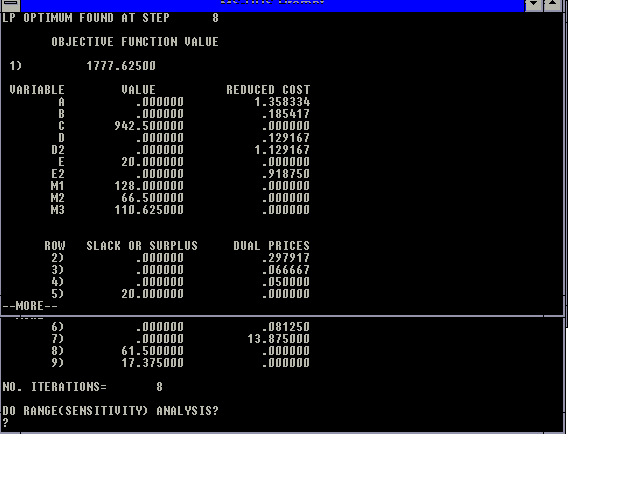
Review this document.
Read sections 1.1-1.9 in the text "Expert Systems: Principles and Programming."
Use the LINDO LP solver software to solve the following problems. Problems are due Friday of week 5 at class time.
60 points
Mon Tue Wed Thu Fri Sat Sun
No. Employees 18 16 15 16 19 14 12
Find the number of employees to schedule to start a five-day stint on each day of the week (use an LP formulation). Note: Be sure to look at the example staff covering problem.
Current
Raw Material % Nitrogen % Phosphorus % Potash World
Price/Ton
AN 50 0 0 $19
SP 1 40 5 18
CP 2 4 35 17.50
BG 1 15 17 21.50
The fertilizer company also has an option to purchase 3-12-12 fertilizer from another company at $19.50/ton. Assuming the cost of mixing and transportation is zero, should the company buy fertilizer from the second company or mix their own? If the company should mix their own fertilizer, what is the proportion of each ingredient?
See the example blending problem for additional help in formulating this type of problem.
Total Distance to
Field Yield (m**3) S1 S2
F1 155 27 km 11 km
F2 282 13 29
F3 261 13 10
F4 455 26 10
Grain will be transported from the fields to the storage locations with a truck that has a capacity of 10 cubic meters. The cost of operating the truck $2.10 per load per kilometer. Find the minimum transportation costs for getting all of the grain from the fields to the storage sites. Also determine the amount of grain from each field that will be hauled to each storage site.
Note: Be sure to look at the example network problem.
In addition to corn and wheat, the farmer may raise hogs and/or chickens. The farmer sells both hogs and chickens after they reach 1 year in age (simplifying assumption). A pig sells for $100 and a coop of chickens sells for $75. Production of one hog requires 25 bushels of wheat or 20 bushels of corn, plus 25 hours of labor and 25 square feet of floor space. One coop of chickens requires 25 bushels of corn or 13 bushels of wheat, plus 37 hours of labor and 15 square feet of floor space.
The farmer owns 10,000 square feet of floor space. He has 2,000 hours of his labor available plus another 2,000 hours from his family. He can also hire additional labor at $5.00 per hour. However, for each hour of hired labor, 0.15 hours of the farmer's time is required for management. How much land should be devoted to corn and how much to wheat? In addition, how many hogs and how many chickens should be produced to maximize the farmer's profits?
Note: Be sure to look at the vertically integrated example problem.
Example staff covering problem.
If one expands one's perspective to the entire economy, then the models considered tend to be similar to the input/output model popularized by Leontief (1951). Each industry is described by the input products produced. These outputs may in turn be inputs to other industries. The problem is to determine appropriate levels at which each industry should be operated in order to satisfy specific consumption requirements.
Select this link to examine a vertically integrated example problem.
One of the simplest network problems is that of finding the shortest route from one point in a network to another. A slight variation on this problem, that of finding the longest route, is an important component of the project management tools PERT (Program Evaluation and Review Technique) and CPM (Critical Path Method).
Game Theory is concerned with the analysis of competitive situations. In its simplest form, a game consists of 2 players, each of whom has available tp him a set of possible decisions. Each player must choose a strategy for making a decision in ignorance of the other player's choice. Some time after a decision is made, each player receives a payoff which depends on which combinations of decisions was made. The problem of determining each player's optimal strategy can be formulated as a linear program.
Machine
Product 1 2 3
A 12 8 5
B 7 9 10
C 8 4 7
D 10 0 3
E 7 11 2
Each of the machines is available 128 hours per week.
Products A, B, and C are purely competitive, and any amounts may be sold at respective prices of $5, $4, and $5. The first 20 units of D and E produced per week can be sold at $4 each, but all made in excess of 20 can only be sold for $3 each. Variable labor costs are $4 per hour for machines 1 and 2 and $3 per hour for machine 3. Material costs are $2 for products A and C and $1 for products B, D, and E. The firm wishes to maximize profit.
Note that the principal complication is that the profit contributions of products D and E are not linear. A technique to eliminate this problem is the definition of 2 products called D2 and E2 which sell for $3 per unit and constrain both D and E to less than or equal to 20 units per week.
First define the decision variables. The following table summarizes the decision variables.
Define Profit Contribution/Unit
A: no. of units of A produced/week 5-2=$3 B: no. of units of B produced/week 4-1=$3 C: no. of units of C produced/week 5-2=$3 D: no. of units of D not in excess of 20 produced/week 4-1=$3 D2: no. of units of D produced in excess of 20 per week. Total production of product D is D + D2 3-1=$2 E: no. of units of E not in excess of 20 produced/week 4-1=$3 E2: no. of units of E produced in excess of 20 3-1=$2 M1: hours of machine 1 used per week -$4 M2: hours of machine 2 used per week -$4 M3: hours of machine 3 used per week -$3
The objective function is:
profit=3A + 3B + 3C + 3D + 2D2 + 3E + 2E2 - 4M1 - 4M2 - 3M3
The constraints are:
12A + 7B + 8C + 10D + 10D2 + 7E + 7E2 - 60M1 = 0 8A + 9B + 4C + 11E + 11E2 - 60M2 = 0 5A + 10B + 7C + 3D + 3D2 + 2E + 2E2 - 60M3 = 0 D < = 20 E < = 20 M1 < = 128 M2 < = 128 M3 < = 128
The solution to this problem is shown in the graphic below.

Hours Collectors Needed
12 am - 6 am 2
6 am to 10 am 8
10 am to noon 4
noon to 4 pm 3
4 pm to 6 pm 6
6 pm to 10 pm 5
10 pm to mid night 3
Each collector works 4 hours, is off one hour (break), and then works another 4 hours. A collector can be started at any hour. Assuming the objective is to minimize the number of collectors hired, formulate the appropriate LP and find the number of workers to hire.
The decision variables are:
X1 = number of collectors to start work at 12 midnight X2 = number of collectors to start work at 1 am .... X24 = number of collectors to start work at 11 pm
The objective is to minimize the number of collectors hired. Therefore, the objective function is:
Minimize X1 + X2 + X3 + .... + X24
The constraint equations are:
X1 + X24 + X23 + X22 + X20 + X19 + X18 + X17 > = 2 (For midnight to 1 am - note X21 not included since on break) X2 + X1 + X24 + X23 + X21 + X20 + X19 + X18 > = 2 (For 1 am to 2 am) ..... X24 + X23 + X22 + X21 + X19 + X18 + X17 + X16 > = 3 (For 11 pm to midnight)
The results are:
Objective function value is 15.75 X1=0 X2=5 X3=0.75 X4=0.75 X5=0.75 X6=0.75 X7=0.75 X8=0 X9=0 X10=0 X11=1 X12=0 X13=0 X14=1 X15=2 X16=1 X17=1 X18=1 X19=0 X20=0 X21=0 X22=0 X23=0 X24=0
Note that the answer is not directly useful because some of the values are fractional. The value 15.75 implies that one should hire at least 16 collectors. This result is obtained by rounding the solution so an integer is obtained, for example by setting X3=X4=X6=X7=1 and X5=0.
Note that for problems of this type, that if the shifts contain no or very few breaks, then the LP solution will tend to be integer without resorting to integer programming.
At Least Not More Than
Carbon Content 3.0% 3.5%
Chrome Content 0.3% 0.45%
Manganese Content 1.35% 1.65%
Silicon Content 2.7% 3.0%
The steel company has the following materials available from which to produce this new steel:
Amount
Cost/lb Carbon Chrome Manganese Silicon Available
Iron1 .03 4.0% 0% 0.9% 2.25% unlimited
Iron2 .0645 0 10.0 4.5 15.0 unlimited
Fe-Sil1 .065 0 0 0 45.0 unlimited
Fe-Sil2 .061 0 0 0 42.0 unlimited
Alloy1 .10 0 0 60.0 18.0 unlimited
Alloy2 .13 0 20.0 9.0 30.0 unlimited
Alloy3 .119 0 8.0 33.0 25.0 unlimited
Carbide .08 15.0 0 0 30.0 20 lb
Steel1 .021 0.4 0 0.9 0 200 lb
Steel2 .02 0.1 0 0.3 0 200 lb
Steel3 .0195 0.1 0 0.3 0 200 lb
A one ton (2000 lb) batch must be blended which satisfies
the quality requirements described.
What is the best blend of materials to use
in producing the new steel?
The decision variables represent each of the materials available to produce the new steel. Let I1 represent Iron1, ..., and S3 represent Steel3.
The objective function is:
Minimize .03I1 + .0645I2 + .065F1 + .061F2 + .10A1 + .13A2
+ .119A3 + .08C + .021S1 + .02S2 + .0195S3
The constraints come from the quality limits (upper and lower content limits), material availability, and the total weight of materials used must total 2000 lb. Thus the constraints are:
.04I1 + .15C + .004S1 + .001S2 + .001S3 < = (2000)(.035) .10I2 + .20A2 + .08A3 < = (2000)(.0045) .009I1 + .045I2 + .60A1 + .09A2 + .33A3 + .009S1 + .003S2 + .003S3 < = (2000)(.0165) .0225I1 + .15I2 + .45F1 + .42F2 + .18A1 + .30A2 + .25A3 + .30C < = (2000)(.03) .04I1 + .15C + .004S1 + .001S2 + .001S3 > = (2000)(.03) .10I2 + .20A2 + .08A3 > = (2000)(.003) .009I1 + .045I2 + .60A1 + .09A2 + .33A3 + .009S1 + .003S2 + .003S3 > = (2000)(.0135) .0225I1 + .15I2 + .45F1 + .42F2 + .18A1 + .30A2 + .25A3 + .30C > = (2000)(.027) C < = 20 S1 < = 200 S2 < = 200 S3 < = 200 I1 + I2 + F1 + F2 + A1 + A2 + A3 + C + S1 + S2 + S3 = 2000
The solution is shown in the figure below.
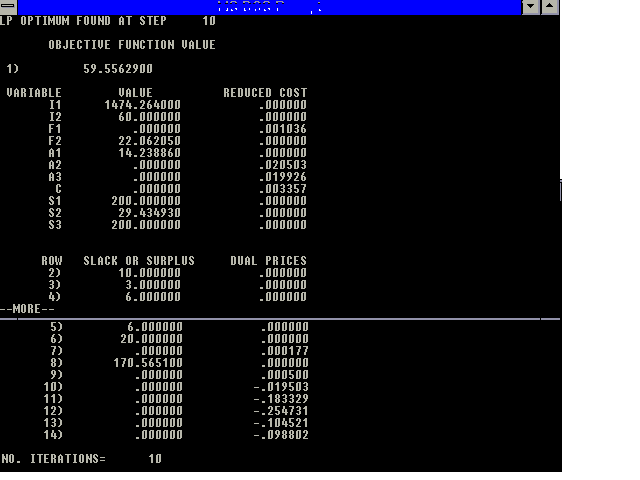
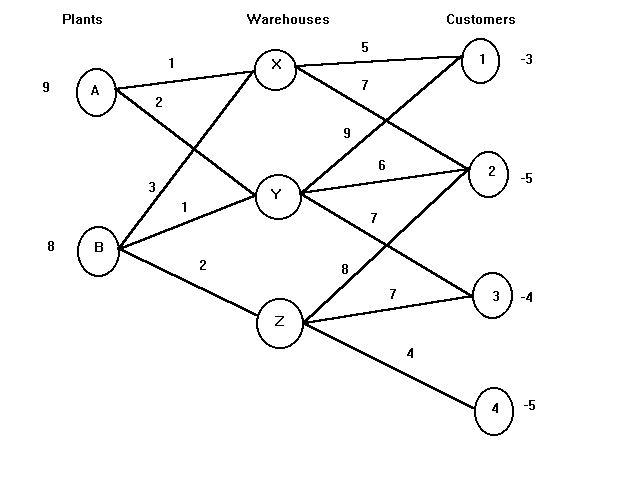
The firm has 2 plants (A and B), 3 warehouses (X, Y and Z) and 4 customer areas (1, 2, 3 and 4). The numbers adjacent to each node denote the availability of material at the node. For example, plant A has 9 units available to be shipped and customer 3 has -4 units (needs 4 units shipped in).
The number above each arc represents the cost per unit shipped along the arc. For example, if 5 of plant A's 9 units are shipped to warehouse Y, a cost of 5 x 2 = 10 is incurred. The problem is to determine the amount shipped along each arc so that total costs are minimized and every customer has their requirements filled.
The main condition of an LP for it to be a network problem is that it be representable as a network. There can be more than 3 levels of nodes and any number of arcs between any 2 nodes and limits may be placed on the amount shipped along an arc.
We will start the example problem by defining the decision variables. Let AX represent the units shipped along the link from plant A to warehouse X. Other variables are similarly defined and will be: AX, AY, BX, BY, BZ, X1, X2, Y1, Y2, Y3, Z2, Z3, and Z4.
The objective function is:
Minimize AX+2AY+3BX+BY+2BZ+5X1+7X2+9Y1+6Y2+7Y3+8Z2+7Z3+4Z4
A constraint is defined for each node such that sources=uses. Thus, the constraints are:
AX+AY=9 BX+BY+BZ=8 -AX-BX+X1+X2=0 -AY-BY+Y1+Y2+Y3=0 -BZ+Z2+Z3+Z4=0 -X1-Y1=-3 -X2-Y2-Z2=-5 -Y3-Z3=-4 -Z4=-5
The results are shown in the figure below.
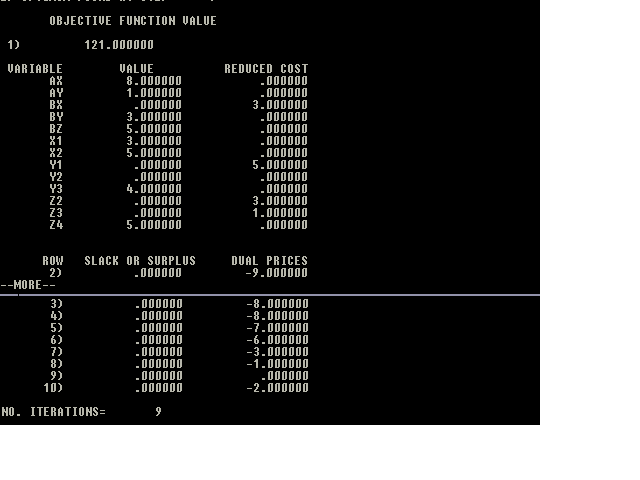
The solution exhibits 2 pleasing features which are found in the solutions of any network problem:
Network LPs can be summarized as follows:
The problem is to determine the flows which minimize total cost subject to satisfying all the supply, demand, and flow constraints.
The following table summarizes other features of the operation.
Labor,
Activity Machinery and Water Land Alfalfa
Other Costs Requirements Requirements Requirements
wheat (ac) $ 12 1.5 ac-ft 1 ac
alfalfa (ac) 16 2.5 ac-ft 1 ac
1 ton beef 145 0.3 ac-ft 0.18 ac 5 tons
Vertically integrated problems such as this can be easily formulated if one carefully:
If we observe that any wheat or beef which is raised will also be sold, then the activities/decision variables can be identified as:
wheat = wheat raised and sold (acres) alfgrow = alfalfa raised (tons) beef = beef raised and sold (tons) alfbuy = alfalfa bought (tons) alfsold = alfalfa sold (tons)
The commodities can be identified by describing the effect of each activity:
Thus the commodities are land, water, and alfalfa with the commodity "dollars" being maximized. There will be constraints describing the usage of land, water and alfalfa.
The objective function is:
maximize 180.5wheat-3.2alfgro+755beef-78alfbuy+75alfsold
The constraints are:
wheat+.2alfgro+.18beef < = 1000 (land constraint) 1.5wheat+.5alfgro+.3beef < = 2200 (water) -alfgro+5beef-alfbuy+alfsold = 0 (alfalfa)
The solution is shown in the figure below.
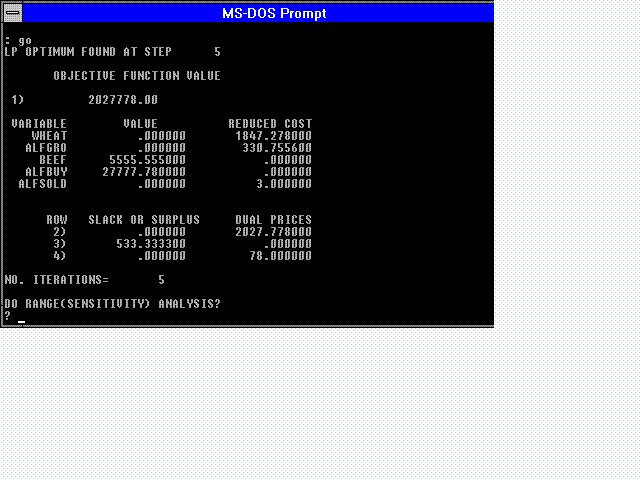
Note that the solution recommends that the entire farm be converted into a cattle feedlot. If this model is a preliminary one, then at this point one would raise questions about constraints which should be added. For example, it may be obvious that a labor constraint is needed. Most model development is iterative and constraints are added as there absence becomes obvious.